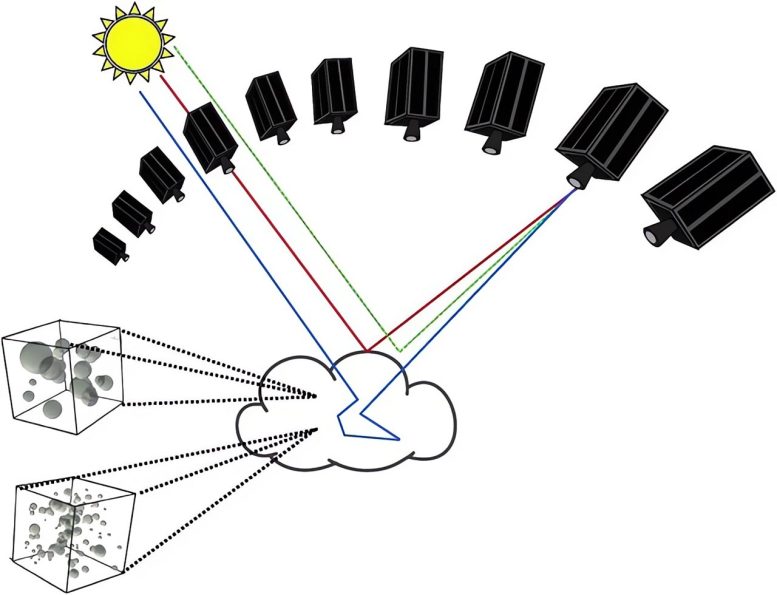

Clouds play a a really highly effective place in regulating Earth’s climate, impacting the water cycle, atmospheric dynamics, and energy stability. Discovering out them, then again, has been troublesome due to boundaries in spaceborne imaging period. Researchers from the Technion have advanced an efficient inverse rendering framework for 3-D cloud distribution restoration. This leap ahead, revealed in Intelligent Computing, addresses earlier demanding conditions in computational worth and large-scale scene applicability, offering new possibilities for scattering-based computed tomography in cloud assertion.
How do clouds kind the planet’s long run? Clouds aren’t merely fluffy white shapes throughout the sky. They’re necessary for regulating the earth’s climate, as they have an effect on the water cycle, atmospheric dynamics and energy stability. Then again, studying clouds isn’t easy. A way to take motion is to utilize spaceborne imagers, nonetheless these imagers nonetheless face demanding conditions of efficiency and scalability. To overcome these boundaries, Ido Czerninski and Yoav Y. Schechner from the Viterbi Faculty of Electrical and Laptop Engineering on the Technion—Israel Institute of Technology, a partner of CloudCT, have advanced an environment friendly inverse rendering framework for enhancing the 3-D distribution of clouds.
Their evaluation was revealed on January 3 in Intelligent Computing, a Science Partner Journal.
This new framework might be utilized for scattering-based computed tomography—that is, scattering CT. Earlier tales have carried out scattering CT for cloud assertion, nonetheless they confronted demanding conditions of computational worth and applicability to large-scale scenes. In addition to, the scattering of the sunshine in clouds varies in step with the wavelength of the sunshine and the scale of the water droplets and totally different airborne particles. This stage of complexity aligns neatly with the world of image rendering and its inversion.

Cloud tomography. Multiple cameras concurrently seize images of a cloud from different angles. These images are later used to determine the shape, amount, and totally different homes of the cloud. Credit score rating: V. Holodovsky, M. Tzabari, and A. Levis
The utilization of a model new algorithm to rush up inverse rendering, the authors had been ready to appropriately and efficiently obtain the 3-D homes of clouds. Inverse rendering is a computational methodology utilized in computer graphics and computer imaginative and prescient to estimate the homes of a 3-D scene, harking back to the shape, lights, and material homes of devices, from a two-dimensional image. The accuracy of the 3D cloud analysis imaging obtained by this new framework was demonstrated using both simulated and real-world data.
This new framework can be used not only for scattering CT, but also in other inverse rendering contexts, such as reflectometry, which uses the reflection of waves at surfaces and interfaces to detect or characterize objects, and x-ray scattering CT scans, which produce images of organs and tissues.
Although this approach represents genuine progress, there are still some issues. The study of cloud climate feedback requires an accurate description of cloud microphysics, which involves the study of physical processes that occur within clouds. However, the current approach represents optical, rather than size and material parameters. Therefore, in future studies, this approach needs to be expanded to include microphysical parameters. This is necessary to fully leverage the methodology of this work for climate studies.
The authors’ key innovation is the “path recycling and sorting” algorithm, which speeds up work on the inverse image rendering problem. Inverse rendering usually requires multiple iterations to refine the variables that define the scene. Each iteration involves rendering operations, but rendering can be quite slow, especially when run hundreds of times during iterative refinements. To overcome this issue, the algorithm recycles paths from previous iterations during the inverse rendering process. This approach uses the paths from prior iterations to estimate a loss gradient at the current iteration, resulting in a significant reduction in iteration run time.
Reference: “PARS – Path recycling and sorting for efficient cloud tomography” by Ido Czerninski and Yoav Y. Schechner, 3 January 2023, Intelligent Computing.
DOI: 10.34133/icomputing.0007
This research was funded in part by the European Research Council under the European Union’s Horizon 2020 research and innovation program.
Supply By means of https://scitechdaily.com/lightning-fast-cloud-tomography-unleashed-new-algorithm-transforms-climate-studies/
jawab.uk

